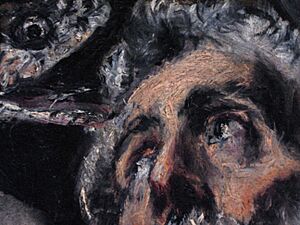Laocoön (El Greco) facts for kids
Quick facts for kids Laocoön |
|
|---|---|
| Artist | El Greco |
| Year | 1610–1614 |
| Type | Oil painting |
| Dimensions | 142 cm × 193 cm (56 in × 76 in) |
| Location | National Gallery of Art, Washington, D.C. |
The Laocoön is a famous oil painting made by the Greek artist El Greco. He painted it between 1610 and 1614. You can see this painting at the National Gallery of Art in Washington, D.C..
The painting shows a story from ancient Greek and Roman myths. It tells about Laocoön, who was a priest from the city of Troy. He and his two sons are being attacked by giant sea snakes. This was a punishment from the gods. Laocoön had tried to warn his people about the Trojan horse, but they did not listen.
El Greco's painting was inspired by a very old sculpture called Laocoön and His Sons. This sculpture was found in Rome not long before El Greco painted his version. However, El Greco's painting is part of an art style called Mannerism. This style was different from the balanced art of the Renaissance. El Greco used strong feelings and stretched-out figures in his work.
Contents
Inspiration for the Painting
El Greco's painting of Laocoön was inspired by two main things: old myths and an ancient sculpture.
Classical Mythology
The story of Laocoön comes from the Trojan War. This was a big war between the Greeks and the people of Troy. Many old stories and poems, like the Aeneid by Virgil, talk about Laocoön.
The war had lasted ten years, and the Greeks could not win. So, they came up with a clever trick: the Trojan Horse. This was a huge, hollow wooden horse filled with Greek soldiers. Laocoön tried to tell his people that the horse was a dangerous trick, not a gift. But the Trojans did not believe him. They brought the horse inside their city walls. This led to the fall of Troy.
Classical Sculpture
The gods supported the Greeks in the Trojan War. They sent sea snakes to kill Laocoön as punishment for trying to warn the Trojans. This sad event is shown in a famous ancient sculpture. It is called Laocoön and His Sons.
This marble sculpture was made around 1st century BCE. It shows Laocoön screaming in pain. He and his sons are struggling against the sea snakes. The sculpture was found in Rome in 1506. Many Renaissance artists loved it because of its perfect figures. El Greco likely saw this sculpture and was inspired to paint his own version.
What the Painting Shows
El Greco's painting captures the final moments of Laocoön and his sons.
Foreground Details
In the middle of the painting, Laocoön is lying on dark, rocky ground. He is in great pain. One of his sons is already dead next to him. A snake is biting Laocoön's head as he tries to hold on to life. On the left, Laocoön's other son twists in pain as a snake attacks his stomach.
On the right side, you can see the gods Apollo and Artemis. They are watching the terrible scene. There is also an unfinished figure, just a head and a leg, on the right.
El Greco made the figures look stretched out and twisted. This was a way to show their suffering. Laocoön's leg is stretched out in an unnatural way. The figures have strange yellow and green colors. This makes the scene feel full of pain and trouble. The dark, scary rocks in the front also add to this intense feeling.
Background Details
El Greco set this ancient story in a gloomy view of the city of Toledo, Spain. Some people believe that the people of Toledo thought they were related to the Trojans. This might be why El Greco used Toledo as the background.
In the painting, the Trojan Horse is moving towards the city. This reminds us that Laocoön's warning failed. El Greco painted Toledo to look like a place of suffering. He used dark colors to create a feeling of doom. The sky is full of swirling, grey clouds. It looks threatening and adds to the sadness of the scene below.
Art Style
El Greco first learned to paint religious pictures in his home country, Crete. Later, he studied art in Venice and Rome. There, he learned about using color and how to arrange figures in a painting. In 1576, El Greco moved to Spain. He settled in Toledo in 1577 and became a church painter.
In Toledo, El Greco developed his unique style. He became a leading artist in the Mannerist movement. He also helped start the Spanish artistic Renaissance. Both of these styles can be seen in Laocoön. This is El Greco's only painting that shows a story from mythology. Even though it's an old story, the painting shows the changes happening in art and society after the Renaissance.
Laocoön clearly shows the influence of Mannerism. This art style started in Italy around the 1520s. It came about during a time of religious trouble, like the Protestant Reformation. Because of the chaos and uncertainty, Mannerist painters moved away from the balanced art of earlier artists like Michelangelo. Instead, they painted figures that were stretched out and twisted. El Greco was one of the best Mannerist painters. You can see this in the distorted figures of Laocoön and his sons, and the elegant gods on the right.
El Greco's paintings often had strong religious themes. This can be seen in Laocoön too. The painting might be about local stories or a comment on the Reformation. But it definitely has a spiritual feeling. Combining deep religious ideas with Mannerist features became a key part of Spanish Renaissance art.
See also
 In Spanish: Laocoonte (El Greco) para niños
In Spanish: Laocoonte (El Greco) para niños
- List of works by El Greco
- Mannerism
- Spanish Renaissance


